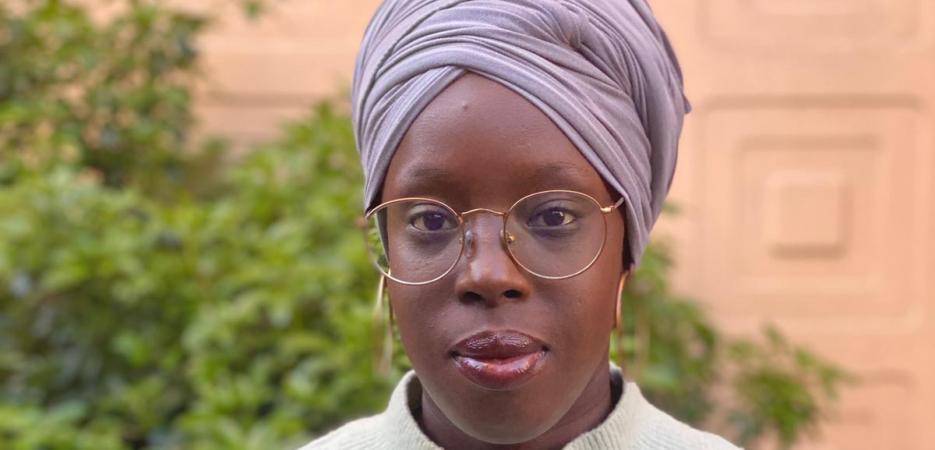- Cinema
- Literature
- New Media
- Performing Arts
- Social Sciences and Humanities
- Visual Arts
- HOU
- LA
- MIA
- NYC
Astrophysicist
November - December 2021

Fatouma Kebe
“I have chosen space debris as my main field of research. I am interested in these remnants of human activity which orbit our planet.”
I became fascinated with celestial bodies after reading the science of astronomy in an encyclopedia, with beautiful images taken by space probes and astronomical observatories. There and then, I decided that my work would one day involve these phenomena, but didn’t really have a profession in mind.
It has been proven that humans were born from stars: some elements of which we are composed come from stars and other components of Space . But although studying Space can help us trace our origins, it doesn’t explain our impact on the environment, which is my other passion. This is why I have chosen space debris as my main field of research. I am interested in these remnants of human activity orbiting our planet that some regard as waste.
When I learned about the history behind humanity’s first steps on the Moon, the Cold War, where one of the goals of both sides was to demonstrate superiority to the other by investing various fields, including Space, I wanted to know more about the decisions and strategies implemented to achieve this. In the United States, Texas was the site of many defining events in this race to Space, particularly at the Lyndon B. Johnson Space Center. The Johnson Space Center is where astronauts are trained and materials from space are stored.
Fatoumata Kebe is a doctor of astronomy at Sorbonne Université. She researches the impact of space activities on astronomical observations, and how such activities contribute to pollution around the Earth. She is also working on “Connected Eco,” an entrepreneurial project for water preservation in the farming sector, and is the founder of the Éphémérides organization, which promotes the practice and teaching of astronomy among the public.
While the Earth was still forming, a celestial body the size of Mars, known as Theia, collided with it. The natural debris from the Earth coalesced with debris from Theia and, over time, formed the Moon.
The aim of the residency will be to produce an audio series that tells the story of the moon rocks that were brought back by the Apollo space missions in 1969–72. A total of 842 pounds of rocks were brought back from the Moon, some still under seal by NASA, to enable future generations of researchers to study them with more advanced technological tools.
As the Moon has no atmosphere, it is constantly bombarded by objects such as meteorites. Studying its specimens means tracing part of our solar system’s history.
I am seeking to (re)discover Space in two different types of environments: Houston and Marfa, TX. Houston has played a pivotal role in American space history. The Lyndon B. Johnson Space Center, which was initially called the Manned Spacecraft Center when it was founded in 1961, has overseen a number of well-known space programs, including Apollo. It occupies an even more vital role today through its involvement in the Artemis Program, which will return American astronauts to the Moon and be the first mission to land a woman on it. The Center is a key location for my project due to the multitude of materials conserved there.
My stay in Marfa will allow me to sort out all the information and knowledge accumulated in Houston and I will be able to start recording the audio series. With its 1,700 inhabitants and a relative absence of infrastructure and pollution, the starry sky will facilitate my transcription work. In cities like Paris and Houston, far fewer than a hundred stars are visible to the naked eye. In Marfa, it is possible to observe more than a thousand.

Art Explora
The brainchild of entrepreneur and philanthropist Frédéric Jousset, the Art Explora Foundation, which launched in November 2019, aims to close the cultural divide through a series of initiatives in France and abroad, drawing on new technologies and mobile systems open to everyone. It seeks to connect works with their audiences and to support new creation and innovation. The Foundation is co-curating eight residencies for the inaugural season of Villa Albertine.

Musée de l’Air et de l’Espace
Located on the historical site of Le Bourget Airport, the National Air and Space Museum of France showcases a unique display of the three domains of flight in its 25,000 square meters of space: aerostation, aviation, and space. With 250,000 annual visitors, the museum also ranks as the first cultural institution in the French department of Seine-Saint-Denis.